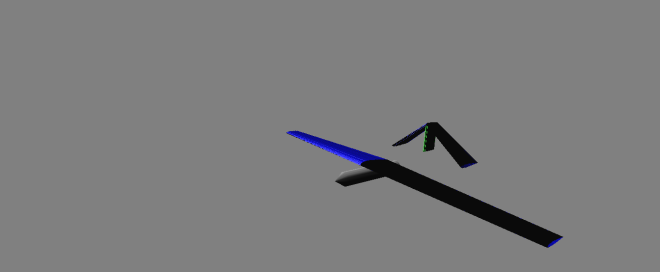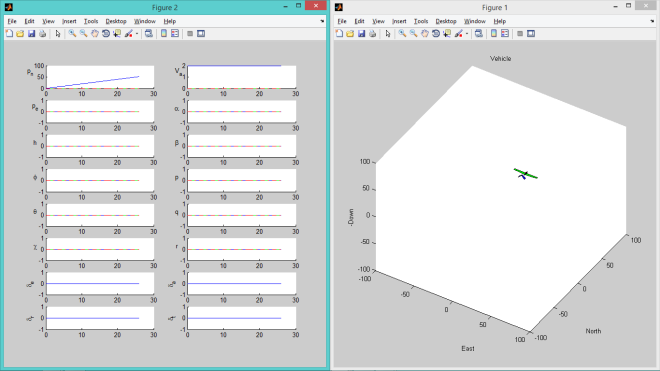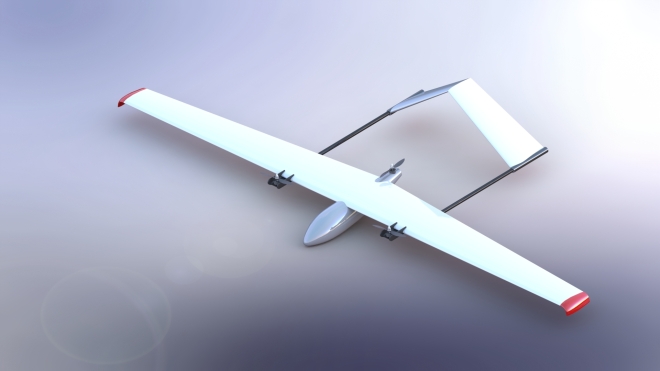Hello all ! It's been a while since I last posted, it's mostly because I've been busy brushing up on Aircraft controls and dynamics so that I can create an autopilot for the VTOL design. We re-iterated our previous design which was a flying wing to a fixed wing aircraft because no matter how much we tried to optimize it, the performance was always below what is achievable from fixed wing UAVs. So we decided to make the switch and moved to a twin boom inverted V-tail design with three motors.
We got a very efficient forward flying characteristics with the design at a cruise speed of around 20 m/s it can fly for an hour and MTOW is 6.2kg. With the design procedure that was almost similar to my previous post where I talked about Flying wing tilt rotor design, we moved to bigger challenges. The first was to control the aircraft during the three flight regimes : hover, transition and take off. To get the control and stability, derivatives the UAV was modeled in USAF DATCOM+ and the required parameters were obtained. But since the software was written in 1976 it doesn't provide support for V-tail. However, after posting on online forums I was told there's hardly a difference in the stability derivatives and hence, the following model was used to get the results. The vertical stabilizer can be seen in the above image which is the drawback of outdated software. However, AVL can also be used to generate control/stability derivatives. I plan to use it in future iterations of the design to get more accurate model. The next step was dynamic modelling of the aircraft in MATLAB. It was started with designing a GUI for visualizing the effect of various input parameters on the UAV. Below is the GUI that was created in MATLAB for the aforementioned purpose.
The vertical stabilizer can be seen in the above image which is the drawback of outdated software. However, AVL can also be used to generate control/stability derivatives. I plan to use it in future iterations of the design to get more accurate model. The next step was dynamic modelling of the aircraft in MATLAB. It was started with designing a GUI for visualizing the effect of various input parameters on the UAV. Below is the GUI that was created in MATLAB for the aforementioned purpose.
Once this was done the rigid body equations were modeled (PS debugging in MATLAB is a pain) and the following window was created. This is a screen-grab of the second version of GUI with control gains that allowed me to change the parameters while running the simulation.
So that's a quick update of what I've been up to. The next step would be to model the aerodynamic equations over the rigid body dynamics skeleton. I plan on first implementing decoupled 3 DOF equation model which I'll later extend to a 6 DOF model of the UAV.
Cheers,
Karan


Comments
Why develop a dynamics model if you are going to just use a simple PID controller?
I think I used the incorrect term for the kind of controller. Yes, that's what I plan to do. I'll be using this dynamic model while designing my autopilot which shall take care of all the three modes i.e. hover,transition and cruise. Instead of just designing a controller around the system errors as in the most autopilots, I'll be using the dynamic model to get a better controller. I'm just starting out in designing autopilots, so it's going to take some work but I'm sure I'll pick it up.
The idea of modelling the transition as quasi static and going from one trim value to another sounds like an implementable model, although I'll need to read up more about it. I have five parameters that need to be trimmed during each step of transition - delta_a,delta_r,delta_t,delta_e and delta_i which is the tilt angle of the motors. I have found the trimmed state yet for the drone and I'm currently trying to find that.
Hello Karan,
No Cascaded PID will do just fine I am sure, however you went through the hazle of finding a Dynamic Model and Designing a Simulation. Therefore I though you would do all that to validate your Flightcontroller with this Simulation.
However you will have differences in your Flight model of your Simulation to the one in Real-life. Therefore if you try to just feedforwarding the Trim values during transition, it might lead to instability if no controller is engaged (that is until you reached the point at which the according Autopilot reengages).
Most people just have a controller for forward flight and hover. Then they just switch and hope for the best, which works in most cases.
If you want to do it professionally then you would design an autopilot for each Trim value in the Transition regime and then switch between those. Therefore you would not only feedforward the Trim values but also have a PID controller (or something more advanced) to stabilize each Trim state. In this manner you go from Trim value to Trim value until you reach your Desired end state.
Anyway let me know what you decided for.
Phil
@Philippe Hey thanks for the reply. No, I haven't seen that I'll check it out. I haven't designed the controller yet, but I'm planning to find the trim states for cruise flight and then as I transition from hover to cruise I'll slowly change my controls to those values and see the trajectory of the drone.
For now I think a cascaded PID just like our normal autopilots should suffice. What do you think ?
@Ryan Thank you. Yes I'm referring to Beard to build an autopilot for transition flight of tiltrotors :)
Nice work, is this based on the BYU matlab sim?
Hey Karan,
very nice! I like your Simulation. However Debugging is one of the few things Matlab is actually good at. Have you seen the step-by-step Debugger in Matlab?
Also which Controller did you use?
Good work!
Phil